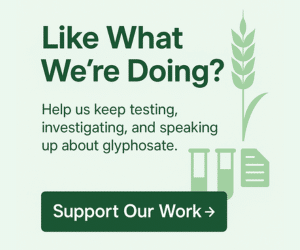Breastmilk is the gold standard of infant nutrition, delivering not just calories and antibodies, but also a microbial seed bank that shapes a child’s lifelong health.
So when testing first reported traces of glyphosate — the world’s most widely used weedkiller — in human breastmilk, it set off alarm bells across scientific and parenting communities alike.
Although research on this issue is still emerging, the possibility that a chemical designed to kill plants could wind up in a newborn’s first food deserves careful examination.
Breastmilk should be the safest food on earth — not a delivery system for weedkiller.
What the Testing Found
In 2014, the non-profit group Moms Across America collaborated with an independent laboratory to test breastmilk samples from mothers in the United States. Their pilot project reported detectable glyphosate levels in 3 out of 10 samples, with concentrations between 76 and 166 micrograms per liter — well above what is permitted in European drinking water, though not directly compared to a legal breastmilk standard.
These results were hotly debated. Critics pointed out the study was small and lacked peer-reviewed controls, while supporters argued it was an urgent red flag demanding further research.
Since then, additional small-scale studies in other countries have also suggested glyphosate can pass into breastmilk, although the frequency and concentration levels vary widely. Overall, there is no comprehensive, large-scale biomonitoring program tracking glyphosate in breastmilk anywhere in the world — including New Zealand.
Why Breastmilk Exposure Matters
Glyphosate is a patented antimicrobial and metal chelator, and it has been shown in lab studies to disrupt beneficial gut bacteria, including Bifidobacterium — one of the very species breastmilk is designed to nurture. If babies are ingesting glyphosate along with the microbes in breastmilk, this could undermine one of the most important gifts breastfeeding offers: a healthy, balanced microbiome.
Infants are uniquely vulnerable to chemical exposures because their detoxification systems, gut barriers, and immune systems are not yet fully developed. Even low-level glyphosate residues might therefore have outsized effects on infant physiology compared to adults.
If you’re unsure how glyphosate enters the food supply in the first place, we’ve mapped the main contamination pathways in our explainer: How Glyphosate Gets Into Our Food.
Gaps in Testing and Oversight
New Zealand currently does not test breastmilk for glyphosate residues, and neither do most countries. Food monitoring programs may occasionally check formula or drinking water, but breastmilk — the most intimate and vital food source — remains outside routine surveillance.
This leaves parents in the dark. While breastfeeding should absolutely be supported and encouraged, families also deserve to know whether environmental chemicals like glyphosate are undermining their best efforts to give their babies a healthy start.
What Can Parents Do?
If you want to limit glyphosate exposure while breastfeeding, consider:
- Choosing organic or glyphosate-free certified foods
- Washing produce thoroughly
- Supporting campaigns for better biomonitoring of breastmilk and infant exposures
- Staying engaged with local and global policy conversations
No parent should have to choose between feeding their baby nature’s perfect food and worrying about chemical contamination.
No parent should have to wonder if their baby is drinking glyphosate along with their first nutrients.
Final Thought
Breastmilk is a remarkable foundation for life — but that foundation can be shaken if we ignore modern chemical threats. New Zealand and other nations urgently need to invest in proper testing, transparency, and policies that protect the smallest and most vulnerable among us. Until then, parents deserve full information about the potential presence of glyphosate in the milk meant to nurture their children’s future.
Further Reading
Chemical residues in breastmilk aren’t just a scientific debate — they strike at the heart of what it means to nourish and protect our youngest generation. These sources will help you dig deeper into why glyphosate’s presence in breastmilk deserves both caution and urgent investigation.
Glyphosate Found in Breast Milk
Moms Across America (2014)
This pilot project was the first to publicly report glyphosate residues in US mothers’ milk, sparking controversy and calls for better biomonitoring.
https://www.momsacrossamerica.com/glyphosate_testing_results
Facts and Fallacies in the Debate on Glyphosate Toxicity
Mesnage & Antoniou (2017)
A scientific review exploring the evidence around glyphosate, including its antimicrobial and potential endocrine-disrupting effects.
https://www.frontiersin.org/articles/10.3389/fpubh.2017.00316/full
The Effect of Glyphosate on Potential Pathogens and Beneficial Members of Poultry Microbiota In Vitro
Shehata et al. (2013)
This in vitro study demonstrated how glyphosate selectively impacts beneficial gut bacteria, raising concerns for infant gut health.
https://link.springer.com/article/10.1007/s00284-012-0277-2
Conclusion on the peer review of the pesticide risk assessment of the active substance glyphosate
EFSA (2015)
The European Food Safety Authority’s official review, discussing residue safety limits but not addressing breastmilk specifically.
https://www.efsa.europa.eu/en/efsajournal/pub/4302
Glyphosate in food
MPI (New Zealand Food Safety)
New Zealand Food Safety’s overview of glyphosate in the food supply, addressing residues and safety standards, but with no reference to breastmilk testing.
Regulating and controlling the use of glyphosate
No family should have to question whether the safest food on earth is safe. The research linked above is only the beginning — and should fuel a broader conversation about what ends up in our children’s first food.
Image Source & Attribution
We’re grateful to the talented photographers and designers whose work enhances our content. The feature image on this page is by HayDmitriy.




